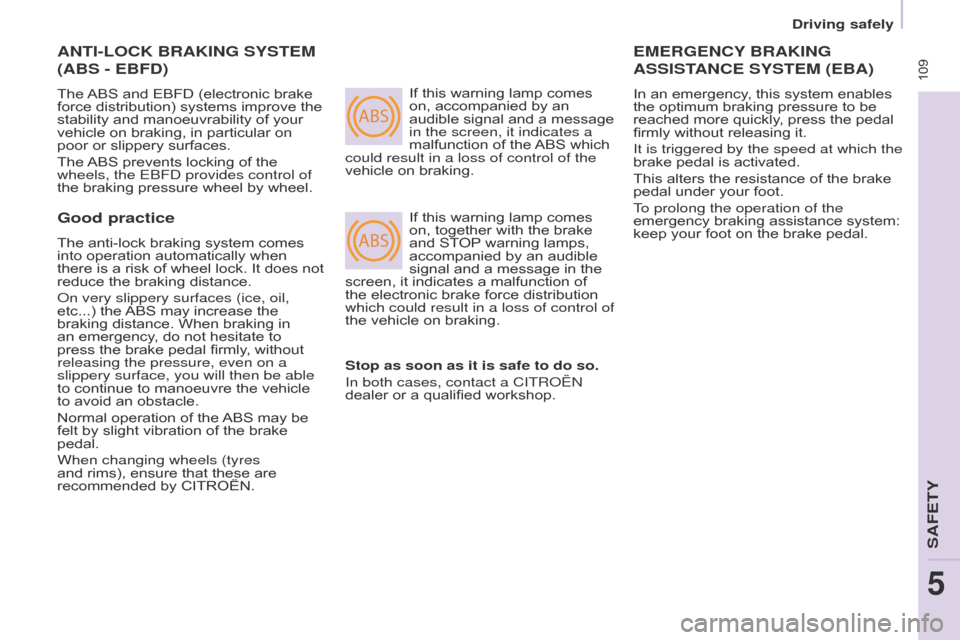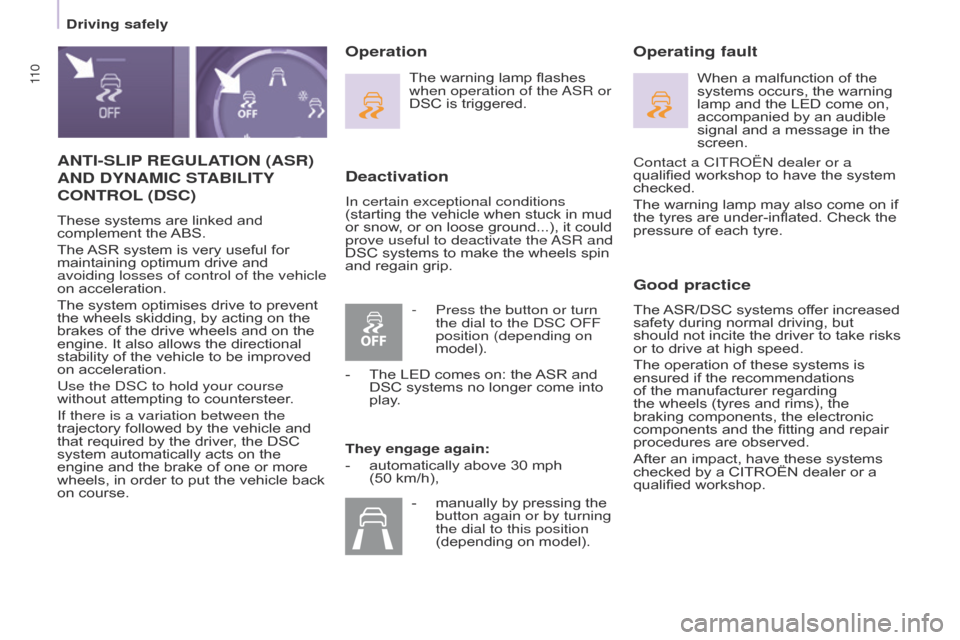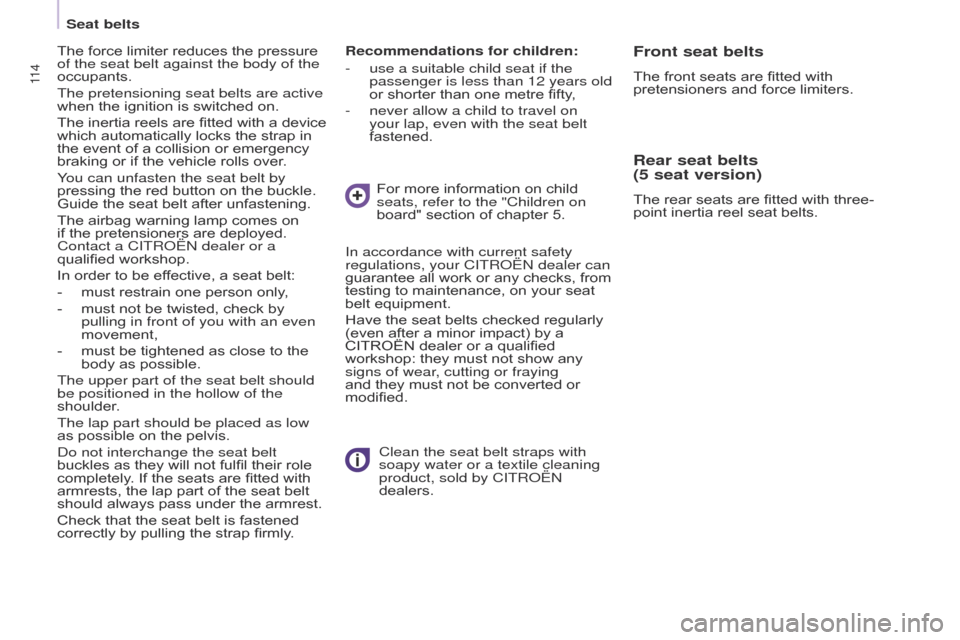Citroen BERLINGO MULTISPACE RHD 2014.5 2.G Owner's Manual
Manufacturer: CITROEN, Model Year: 2014.5, Model line: BERLINGO MULTISPACE RHD, Model: Citroen BERLINGO MULTISPACE RHD 2014.5 2.GPages: 276, PDF Size: 12.15 MB
Page 111 of 276

ABS
ABS
109
Berlingo_2_VP_en_Chap05_Securite_ed02-2014
AntI-LOcK BrAKInG SYStEM
(ABS - EBF d )
The ABS and EBFD (electronic brake force
distribution) systems improve the
stability
and manoeuvrability of your
vehicle
on braking, in particular on
poor
or slippery surfaces.
The
ABS
prevents locking of the
wheels, the EBF
d provides control of
the
braking pressure wheel by wheel.If
this warning lamp comes on,
accompanied by an
audible
signal and a message
in the screen, it indicates a
malfunction
of the
ABS
which
could result in a loss of control of the
vehicle
on braking.
If
this warning lamp comes
on,
together with the brake
and
STOP
warning lamps,
accompanied
by an audible
signal
and a message in the
screen,
it indicates a malfunction of
the
electronic brake force distribution
which could result in a loss of control of
the
vehicle on braking.
EMErGEncY BrAKInG
ASSIS t
A
nc E SYS t EM (EBA)
In an emergency, this system enables the optimum braking pressure to be
reached
more quickly, press the pedal
firmly
without releasing it.
It is triggered by the speed at which the
brake
pedal is activated.
This
alters the resistance of the brake
pedal
under your foot.
To prolong the operation of the
emergency
braking assistance system:
keep
your foot on the brake pedal.
Good practice
The anti-lock braking system comes into operation automatically when
there
is a risk of wheel lock. It does not
reduce
the braking distance.
o
n very slippery surfaces (ice, oil,
etc...)
the
ABS
may increase the
braking
distance. When braking in
an
emergency, do not hesitate to
press
the brake pedal firmly, without
releasing the pressure, even on a
slippery surface, you will then be able
to
continue to manoeuvre the vehicle
to
avoid an obstacle.
Normal
operation of the
ABS
may be
felt
by slight vibration of the brake
pedal.
When changing wheels (tyres
and
rims), ensure that these are
recommended
by CITROËN. Stop as soon as it is safe to do so.
In both cases, contact a CITR
o Ë n
dealer
or a qualified workshop.
driving safely
SaFETY
5
Page 112 of 276

11 0
Berlingo_2_VP_en_Chap05_Securite_ed02-2014
AntI-SLIP rEGuLAtIO n (AS r )
A nd d Y n AMI c S t
ABILI
t Y
c
O ntr OL ( d S c )
These systems are linked and complement the ABS.
The
ASR
system is very useful for
maintaining
optimum drive and
avoiding losses of control of the vehicle
on
acceleration.
The
system optimises drive to prevent
the
wheels skidding, by acting on the
brakes
of the drive wheels and on the
engine.
It also allows the directional
stability
of the vehicle to be improved
on
acceleration.
Use the
d SC to hold your course
without
attempting to countersteer.
If there is a variation between the
trajectory
followed by the vehicle and
that
required by the driver, the DSC
system
automatically acts on the
engine
and the brake of one or more
wheels,
in order to put the vehicle back
on
course.
deactivation
In certain exceptional conditions
(starting the vehicle when stuck in mud
or
snow, or on loose ground...), it could
prove useful to deactivate the a
SR and
DSC
systems to make the wheels spin
and
regain grip.
Operating fault
Good practice
The ASR/DSC systems offer increased safety
during normal driving, but
should
not incite the driver to take risks
or
to drive at high speed.
The
operation of these systems is
ensured
if the recommendations
of
the manufacturer regarding
the
wheels (tyres and rims), the
braking
components, the electronic
components
and the fitting and repair
procedures
are observed.
After
an impact, have these systems
checked
by a CITROËN dealer or a
qualified
workshop.
Operation
The warning lamp flashes when operation of the a SR or
DSC
is triggered.
t
hey engage again:
-
automatically
above 30 mph
(50
km/h), When
a malfunction of the systems
occurs, the warning
lamp
and the LED come on,
accompanied
by an audible
signal
and a message in the
screen.
-
Press the button or turn
the dial to the
d SC o FF
position (depending on
model).
-
The
LED comes on: the
ASR
and
DSC
systems no longer come into
play
. -
manually
by pressing the
button again or by turning
the dial to this position
(depending
on model).Contact a CITR
o Ë n dealer or a
qualified
workshop to have the system
checked.
The
warning lamp may also come on if
the
tyres are under-inflated. Check the
pressure
of each tyre.
driving safely
Page 113 of 276

111
Berlingo_2_VP_en_Chap05_Securite_ed02-2014
GrIP cO ntr OL
correct use
Y our vehicle is designed principally to
drive
on tarmac roads but it allows you
to drive on other less passable terrain
occasionally
.
However, particularly when your
vehicle is heavily laden, it does not
permit
off-road activities such as:
-
crossing and driving on ground
which
could damage the underbody
or
tear off components (fuel pipe,
fuel
cooler, ...), particularly by
obstacles or stones,
-
driving on ground with steep
gradients and poor grip,
-
crossing
a stream.
On
snow,
mud
or
sand,
traction
control
is
obtained
by
a
compromise
between
safety
, grip, traction and appropriate
tyres.
It
adapts
to
allows
most
conditions
of
poor
grip
to
be
accommodated.
The
accelerator
pedal
must
be
pressed
enough
for
there
to
be
adequate
engine
power
to
manage
the
various
parameters
in
the
best
way.
driving safely
SaFETY
5
Page 114 of 276

11 2
Berlingo_2_VP_en_Chap05_Securite_ed02-2014
This dSc mode is calibrated for a low level of skidding,
based on dif
ferent conditions
of grip encountered on the
road.
When the ignition is switched off,
the
system returns automatically to
DSC
mode. This
d S c OFF mode is
only
suitable for specific
conditions encountered
when
moving off or at low
speed.
Above
30
mph (50 km/h) the system
returns
to
DSC mode automatically. This
snow mode allows the vehicle to adapts its strategy
to the conditions of grip
encountered for each of the
two
front wheels, on moving
of
f.
When
moving, the system optimises
wheelspin to provide the best
acceleration possible for the grip
available.This
off-road mode (mud,
wet
grass...) allows, when
moving
off, considerable
wheelspin on the wheel
with the least grip to favour
clearing
of the mud and regain "grip".
At
the same time, the wheel with the
most
grip is controlled in such a way as
to
transmit as much torque as possible.
When
moving, the system optimises
wheelspin
to meet the driver's
requirements
as fully as possible.This sand
mode allows a little wheelspin on the two
driving
wheels at the same
time
to allow the vehicle to
move
forward and reduces
the
risk of getting stuck in the sand.
Do
not use the other modes on sand
as
the vehicle may become stuck.
driving safely
Page 115 of 276

Berlingo_2_VP_en_Chap05_Securite_ed02-2014
11 3
SEAt BELt S
Height adjustment
Squeeze the control with the return and slide
the assembly on the driver's seat
side and on the individual passenger
seat
side.
Fastening
Pull the strap, then insert the tongue
into the buckle.
Check
that the seat belt is fastened
correctly
by pulling the strap.
Seat belt not fastened warning lamp
unfastening
Press the red button.
When the vehicle is started,
this
warning lamp comes on
if a user at the front has not
fastened
their seat belt.
Good practice
The driver must ensure that passengers use the seat belts correctly
and that they are all strapped in
securely before moving off.
Wherever you are seated in the
vehicle, always fasten your seat belt,
even
for short journeys.
The
seat belts are fitted with an inertia
reel
which automatically adjusts the
length
of the strap to your size.
d
o not use accessories (clothes pegs,
clips,
safety pins, etc.) which allow the
seat
belt straps to fit loosely.
Ensure that the seat belt has reeled in
correctly
after use.
After
folding or moving a seat or a rear
bench seat, ensure that the seat belt
has reeled in correctly and that the
buckle
is ready to accommodate the
tongue.
d
epending on the nature and
seriousness
of any impact, the
pretensioning
device may be deployed
before
and independently of inflation
of
the airbags. It instantly tightens
the seat belts against the body of the
occupants.
Deployment
of the pretensioners is
accompanied
by a slight discharge
of
harmless smoke and a noise, due
to the activation of the pyrotechnic
cartridge
incorporated in the system.
the
front
passenger's
seat
may
be
fitted
with
a
presence
detector
,
in
which
case you should not place anything
heavy on this seat as this could trigger
the
alert.
Seat belts
SaFETY
5
Page 116 of 276

11 4
Berlingo_2_VP_en_Chap05_Securite_ed02-2014
recommendations for children:
-
use a suitable child seat if the
passenger is less than 12 years old
or
shorter than one metre fifty,
-
never allow a child to travel on
your lap, even with the seat belt
fastened. For
more information on child
seats, refer to the "Children on
board"
section of chapter 5.
Clean the seat belt straps with
soapy water or a textile cleaning
product, sold by CITR
o Ë n
dealers.
In accordance with current safety
regulations, your CITR
o Ë n dealer can
guarantee
all work or any checks, from
testing
to maintenance, on your seat
belt
equipment.
Have
the seat belts checked regularly
(even
after a minor impact) by a
CITROËN
dealer or a qualified
workshop:
they must not show any
signs of wear
, cutting or fraying
and
they must not be converted or
modified.
The
force
limiter
reduces
the
pressure
of the seat belt against the body of the
occupants.
The pretensioning seat belts are active
when
the
ignition
is
switched
on.
The
inertia
reels
are
fitted
with
a
device
which
automatically
locks
the
strap
in
the
event
of
a
collision
or
emergency
braking
or
if
the
vehicle
rolls
over.
You can unfasten the seat belt by
pressing
the
red
button
on
the
buckle.
Guide
the
seat
belt
after
unfastening.
The
airbag
warning
lamp
comes
on
if
the
pretensioners
are
deployed.
Contact a CITR
o
Ë
n
dealer or a
qualified
workshop.
In
order
to
be
effective,
a
seat
belt:
-
must
restrain
one
person
only,
-
must
not
be
twisted,
check
by
pullin
g in front of you with an even
movement,
-
must
be
tightened
as
close
to
the
body
as
possible.
The upper part of the seat belt should
be positioned in the hollow of the
shoulder.
The lap part should be placed as low
as
possible
on
the
pelvis.
d
o not interchange the seat belt
buckles
as
they
will
not
fulfil
their
role
completely
.
If
the
seats
are
fitted
with
armrests,
the
lap
part
of
the
seat
belt
should
always
pass
under
the
armrest.
Check
that
the
seat
belt
is
fastened
correctly
by
pulling
the
strap
firmly.Front seat belts
The front seats are fitted with pretensioners and force limiters.
rear seat belts
(5 seat version)
The rear seats are fitted with three-
point inertia reel seat belts.
Seat belts
Page 117 of 276

Berlingo_2_VP_en_Chap05_Securite_ed02-2014
11 5
rear seat belts
(7 seat version)
In row 2
The
three seats are fitted with three-
point
inertia reel seat belts.
When folding the side seats or the
seat
backs to the table position, avoid
trapping the strap of the centre seat
belt.
When handling the side seats
(removing/installin
g) or when
accessing
row 3, avoid hooking the
centre
seat belt.
Ensure that the centre seat belt is
rolled up correctly in its strengthener
on
the roof. In row 3
The
two seats are fitted with three-
point inertia reel seat belts.d
o not attach the seat belts to the
stowing
rings marked with a red cross,
represented
on the label.
Take
care to hook the seat belts
correctly on the rings provided for this
purpose.The row 3 seat belts which are not in
use can be stored to clear the load
space
and make use of the load space cover
easier.
Hook the snap hook in the location provided
on the rear pillar trim.
Seat belts
SaFETY
5
Page 118 of 276

11 6
Berlingo_2_VP_en_Chap05_Securite_ed02-2014
AIrBAGS
General information
The airbags have been designed to
maximise the safety of the occupants
in the event of a serious collision;
they
work in conjunction with the force
limiting
seat belts. In the event of a serious collision, the
electronic detectors record and analyse
the
front and side impacts suffered in the
impact detection zones:
-
in
the event of a serious impact,
the
airbags inflate instantly and
contribute towards better protecting
the occupants of the vehicle;
immediately
after the impact, the
airbags
deflate rapidly, so that they
do not hinder the visibility of the
occupants nor their possible exit
from
the vehicle.-
in
the event of a minor or rear impact
and in certain roll-over conditions, the airbags will not be
deployed; the seat belt alone is
sufficient
to contribute towards your
protection
in these situations.
The seriousness of the collision
depends on the nature of the obstacle
and the speed of the vehicle at the
moment
of impact.
airbags
Page 119 of 276

117
Berlingo_2_VP_en_Chap05_Securite_ed02-2014
Good practice
Sit in a normal upright position.
W ear a correctly adjusted seat belt.
d
o not leave anything between the
occupants and the airbags (a child,
pet,
object...).
This
could hinder the
operation
of the airbags or injure the
occupants.
a
fter an accident or if the vehicle has
been
stolen or broken into, have the
airbag
systems checked.
All
work on the airbag system is strictly
forbidden unless it is carried out by
qualified
personnel at a CITROËN
dealer
or a qualified workshop.
Even if all of the precautions
mentioned
are observed, a risk of
injury
or of minor burns to the head,
chest
or arms when an airbag is
deployed
cannot be ruled out. In fact,
the
bag inflates almost instantly (within
a
few milliseconds) then deflates within
the
same time discharging the hot gas
via
openings provided for this purpose.Lateral airbags
Only
put recommended covers on
the
seats.
These
will not hinder
inflation
of the lateral airbags. Contact
a
CITROËN dealer or a qualified
workshop.
Do
not fix or attach anything to the seat
backs.
This
could cause injury to the
chest
or arms when the lateral airbag
inflates.
d
o not sit with the upper part of the
body any nearer to the door than
necessary.
Front airbags
d
o not drive holding the steering wheel
by
its spokes or resting your hands on
the
centre part of the wheel.
d
o not allow passengers to place
their
feet on the dashboard, they risk
serious
injury if the airbag is deployed.
Smoke
as little as possible as
deployment
of the airbags can cause
burns
or the risk of injury from a
cigarette
or pipe.
Never
remove or pierce the steering
wheel
or hit it violently.
Airbags only operate when the
ignition is switched on.
This
equipment
only
operates
once.
If
a
second
impact
occurs
(during
the
same
or
a
subsequent
accident),
the
airbag
will
not
operate.
The
deployment
of
an
airbag
or
airbags
is
accompanied
by
a
slight
discharge
of
smoke
and
a
noise,
due
to
the
activation of the pyrotechnic cartridge
incorporated
in
the
system.
This
smoke
is
not
harmful,
but
sensitive
individuals
may
experience
some
irritation.
The
noise
of
the
detonation
may
result
in a slight loss of hearing for a short
time. The
passenger's
front
airbag
must
be deactivated if a child seat is
installed
facing
rearward.
Chapter 5, "Children on board"
section.
airbags
SaFETY
5
Page 120 of 276

11 8
Berlingo_2_VP_en_Chap05_Securite_ed02-2014
curtain airbags
This is a system which protects the driver and passengers (with the
exception of the centre seat of row 2)
in the event of a serious side impact in
order
to limit the risk of head injuries.
Each curtain airbag is incorporated in
the pillars and the upper part of the
passenger
compartment.
Activation
It
is triggered at the same time as the
corresponding lateral airbag in the
event
of a serious side impact applied
to
all or part of the side impact zone B,
perpendicular to the longitudinal
centreline of the vehicle on a horizontal
plane
and directed from the outside
towards
the inside of the vehicle.
The
curtain airbag inflates between the
front or rear occupant of the vehicle
and
the windows.
Lateral airbags
This is a system which protects the driver and front passenger in the event
of a serious side impact in order to limit
the
risk of injury to the chest.
Each
lateral airbag is fitted in the front
seat
backrest frame, on the door side.
d
eployment
It is deployed unilaterally in the event
of
a serious side impact applied to
all
or part of the side impact zone B,
perpendicular to the longitudinal
centreline of the vehicle on a horizontal
plane
and directed from the outside
towards
the inside of the vehicle.
The
lateral airbag inflates between the
front occupant of the vehicle and the
corresponding
door trim panel.Impact detection zones
A.
Front impact zone.
B. Side impact zone.Operating fault
If this warning lamp comes
on
in the instrument panel,
accompanied
by an audible
signal
and a message in the
screen, contact a CITR
o Ë n
dealer or a qualified workshop to have
the
system checked.
The
airbags may
no longer be deployed in the event of a
serious
impact.
In the event of a minor impact or
bump
on the side of the vehicle or
if the vehicle rolls over
, the airbag
may
not be deployed.
airbags